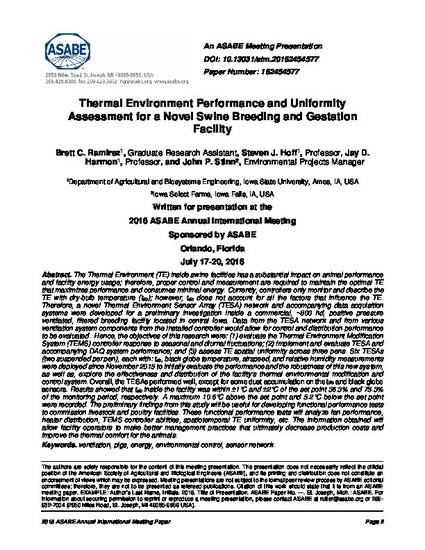
The Thermal Environment (TE) inside swine facilities has a substantial impact on animal performance and facility energy usage; therefore, proper control and measurement are required to maintain the optimal TE that maximizes performance and consumes minimal energy. Currently, controllers only monitor and describe the TE with dry-bulb temperature (tdb); however, tdb does not account for all the factors that influence the TE. Therefore, a novel Thermal Environment Sensor Array (TESA) network and accompanying data acquisition systems were developed for a preliminary investigation inside a commercial, ~800 hd, positive pressure ventilated, filtered breeding facility located in central Iowa. Data from the TESA network and from various ventilation system components from the installed controller would allow for control and distribution performance to be evaluated. Hence, the objectives of this research were: (1) evaluate the Thermal Environment Modification System (TEMS) controller response to seasonal and diurnal fluctuations; (2) implement and evaluate TESA and accompanying DAQ system performance; and (3) assess TE spatial uniformity across three pens. Six TESAs (two suspended per pen), each with: tdb, black globe temperature, airspeed, and relative humidity measurements were deployed since November 2015 to initially evaluate the performance and the robustness of this new system, as well as, explore the effectiveness and distribution of the facility’s thermal environmental modification and control system. Overall, the TESAs performed well, except for some dust accumulation on the tdb and black globe sensors. Results showed that tdb inside the facility was within ±1°C and ±2°C of the set point 36.3% and 75.3% of the monitoring period, respectively. A maximum 10.6°C above the set point and 5.2°C below the set point were recorded. The preliminary findings from this study will be useful for developing functional performance tests to commission livestock and poultry facilities. These functional performance tests will analyze fan performance, heater distribution, TEMS controller abilities, spatiotemporal TE uniformity, etc. The information obtained will allow facility operators to make better management practices that ultimately decrease production costs and improve the thermal comfort for the animals.
Available at: http://works.bepress.com/brett-ramirez/13/

This proceeding is published as Ramirez, Brett C., Steven J. Hoff, Jay D. Harmon, and John P. Stinn. "Thermal Environment Performance and Uniformity Assessment for a Novel Swine Breeding and Gestation Facility." In 2016 ASABE Annual International Meeting. ASABE Paper 2454577. American Society of Agricultural and Biological Engineers, 2016. 10.13031/aim.20162454577. Posted with permission.